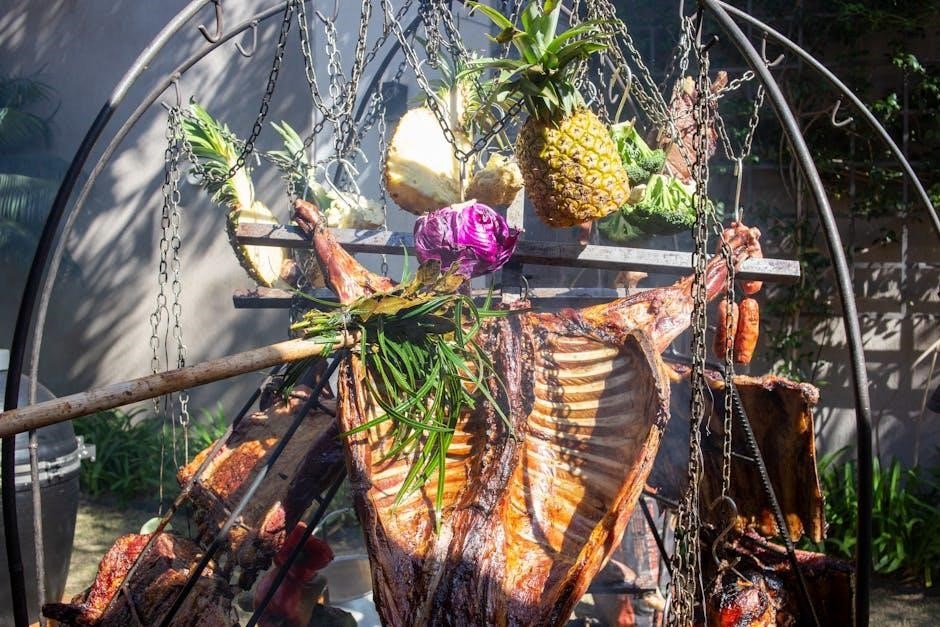Food chains trace energy flow through ecosystems, while food webs are interconnected chains showing how organisms depend on each other. Both are vital for understanding ecosystem dynamics and energy transfer.
Definition and Importance
A food chain is a linear sequence showing how energy flows from one organism to another in an ecosystem, while a food web is a network of interconnected food chains. Both concepts are essential for understanding ecosystem dynamics. Food chains and webs help identify producers (like plants) and consumers (like animals), showing energy transfer and trophic levels. They are crucial for studying how changes in one part of an ecosystem can impact others, making them vital tools in ecology and environmental education.
Differences Between Food Chains and Food Webs
A food chain is a straightforward, linear pathway that shows energy flow from one organism to another. It represents a single route of energy transfer. In contrast, a food web is a complex network of multiple food chains interwoven together. It illustrates how various organisms are interconnected, showing multiple pathways of energy flow. While a food chain focuses on a specific sequence, a food web provides a broader view of an ecosystem’s structure and energy dynamics, highlighting biodiversity and interdependencies.
Producers and Consumers in Food Chains
Producers, such as plants and algae, make their own food via photosynthesis. Consumers eat other organisms to gain energy, forming the base of food chains and energy flow.
Identifying Producers
Producers are organisms that create their own food through photosynthesis. In a food chain or web, they are typically plants, algae, or bacteria. To identify them, look for organisms that do not consume others. For example, in the chain grass → rabbit → fox, grass is the producer. Producers form the base of ecosystems, providing energy for all other organisms. They are crucial for starting the energy flow, making them essential for sustaining life in any environment.
Types of Consumers: Herbivores, Carnivores, Omnivores
Consumers are organisms that obtain energy by eating other organisms. Herbivores, like rabbits, eat plants. Carnivores, such as foxes, consume other animals. Omnivores, like humans, eat both plants and animals. Each type plays a unique role in ecosystems, balancing energy flow and maintaining biodiversity. Identifying these consumer types helps students understand food chain dynamics and trophic levels, essential for analyzing ecosystems effectively.
Understanding the Worksheet
The worksheet helps students analyze food chains and webs, identifying producers, consumers, and energy flow. It includes exercises and an answer key for self-assessment and clarity.
How to Approach the Food Chains and Food Webs Worksheet
To tackle the worksheet, start by identifying producers and consumers in each food chain. Next, analyze the flow of energy and label trophic levels. For food webs, trace connections between organisms and construct possible chains. Use the answer key to verify responses and review misconceptions. Practice exercises reinforce understanding of ecological relationships and energy transfer dynamics in ecosystems.
Example Food Chain Analysis
Consider the food chain: lettuce → greenfly → ladybug → thrush → cat. The lettuce is the producer, converting sunlight into energy. The greenfly, as a herbivore, eats the lettuce, representing the first trophic level. The ladybug, a carnivore, feeds on the greenfly, forming the second trophic level. The thrush, another carnivore, eats the ladybug, becoming the third trophic level. Finally, the cat, as a tertiary consumer, eats the thrush. Arrows indicate energy flow from one organism to another, showing how energy decreases at each level.
Answer Key and Explanations
This section provides correct answers and detailed explanations for common questions about food chains and webs. It clarifies key concepts like producers, consumers, and energy flow.
Correct Answers to Common Questions
This section provides accurate answers to frequently asked questions about food chains and webs. It clarifies the meaning of arrows, identifying producers, and differentiating between herbivores, carnivores, and omnivores. For example, in the chain grass → rabbit → fox, grass is the producer, the rabbit is a herbivore, and the fox is a carnivore. Such explanations help students grasp fundamental concepts clearly and effectively.
Common Misconceptions and Clarifications
A common misconception is that all food chains are linear, but they often form complex webs. Many students confuse producers with consumers, thinking all plants are producers, which is correct, but some may overlook algae or phytoplankton. Additionally, assuming that all arrows in a food web represent predator-prey relationships is incorrect, as some may indicate scavenging. Clarifying these points helps students better understand ecosystem interactions and energy flow.

Energy Flow in Ecosystems
Energy flows through ecosystems via food chains and webs, primarily from the sun to producers, then to consumers. Each transfer loses energy, supporting life sustainably.
The Role of Energy in Food Chains and Food Webs
Energy is the foundation of food chains and webs, flowing from producers to consumers. It starts with photosynthesis, where plants convert sunlight into energy. This energy is transferred through consumption, supporting each trophic level. Decomposers return energy to the ecosystem, maintaining balance. Understanding energy flow is crucial for analyzing ecosystem health and sustainability.
Energy Pyramid and Its Relation to Food Chains
An energy pyramid visually represents the flow of energy through ecosystems. It shows that energy decreases at each trophic level, with producers at the base having the most energy. Only 10% of energy is transferred to the next level, explaining why higher consumers have less energy available. This hierarchy reflects the inefficiency of energy transfer and highlights the importance of maintaining balanced ecosystems. It directly relates to food chains by illustrating why top predators rely on a broad base of producers.
Constructing a Food Web
A food web illustrates how energy flows between organisms in an ecosystem. Start by identifying producers, then add consumers, and use arrows to show energy transfer directions.
Step-by-Step Guide to Building a Food Web
Identify producers, like plants, at the base. 2. Add primary consumers that eat producers. 3. Include secondary and tertiary consumers. 4. Use arrows to show who eats whom. 5. Ensure all organisms are interconnected to reflect ecosystem dynamics accurately. This method helps visualize energy flow and dependencies within an ecosystem, making it easier to understand complex relationships. Start simple and expand as needed for clarity.
Interpreting Interrelationships in a Food Web
A food web illustrates the complex interactions between organisms, showing how energy flows through an ecosystem. Producers form the base, providing energy for consumers. Each organism’s role and its connections reveal dependencies and energy pathways. Analyzing these relationships helps understand ecosystem balance, the impact of species loss, and the resilience of the food web. Identifying keystone species and their roles is crucial for maintaining ecosystem stability and biodiversity.

Worksheet Questions and Answers
The worksheet includes questions on identifying producers, consumers, and trophic levels, with an answer key to verify responses and deepen understanding of food chains and webs.
Sample Questions from the Worksheet
Sample questions include identifying producers, consumers, and trophic levels in food chains and webs. For example, “Name the producer in the food chain: lettuce → greenfly → ladybug → thrush → cat” and “Explain what could happen to the community if all the frogs suddenly died.” These questions test understanding of energy flow, ecosystem interdependencies, and the impact of disruptions, providing practical examples to reinforce learning.
Answering Questions Using the Food Web
To answer questions using a food web, analyze the relationships between organisms, identifying producers, consumers, and their connections. For example, in a food web, determine who eats whom and how energy flows. Use the web to construct food chains, explain ecosystem dynamics, and predict impacts of changes, like the loss of a species. This approach helps students understand how food webs represent the interconnected nature of ecosystems and the flow of energy within them.

Case Studies and Examples
Real-world examples, like grassland ecosystems, demonstrate food chains (e.g., grass → rabbit → fox) and food webs, showing how energy flows through interconnected species in nature.
Real-World Applications of Food Chains and Food Webs
Understanding food chains and webs is crucial for conservation, agriculture, and environmental science. They help predict ecosystem changes, manage wildlife, and develop sustainable farming practices. For instance, analyzing a marine food web can inform fisheries management, while terrestrial food chains aid in forest restoration. These tools are essential for maintaining biodiversity and ensuring ecosystem balance in natural and human-altered environments.
Ecological Implications of Food Web Disruptions
Disrupting food webs can have cascading effects on ecosystems, leading to population declines, biodiversity loss, and instability. Changes in one species can impact multiple trophic levels, altering energy flow and nutrient cycles. For example, overfishing can deplete prey populations, affecting predators and causing ecosystem imbalance. Invasive species can disrupt native food webs, leading to species extinction. Understanding these dynamics is crucial for conservation and managing human impacts on ecosystems to maintain ecological balance and resilience.

Review and Practice
Review key concepts like producers, consumers, and energy flow. Practice identifying food chains and webs, analyzing trophic levels, and understanding ecosystem dynamics through guided exercises and worksheets.
Key Concepts to Remember
Key concepts include understanding producers as the base of ecosystems, consumers as organisms that eat others, and the flow of energy through food chains and webs. Recognize trophic levels: producers (level 1), herbivores (level 2), carnivores (level 3), and omnivores. Energy decreases at each level due to the 10% rule. Food webs show multiple pathways, unlike single food chains. These concepts are crucial for analyzing ecosystem balance and interdependencies.
Practice Exercises for Reinforcement
Practice identifying producers, consumers, and trophic levels in food chains and webs. Create food chains from given organisms and analyze their energy flow. Answer questions about ecosystem impacts, like species removal effects. Match organisms to their roles (herbivore, carnivore, omnivore). Label and interpret food web diagrams. Complete fill-in-the-blank exercises using vocabulary like “food chain,” “food web,” and “energy pyramid.” Use provided answer keys to verify accuracy and reinforce understanding of ecological relationships.
Food chains and food webs are essential for understanding energy flow in ecosystems. They highlight the interconnectedness of species and the importance of biodiversity for ecosystem balance.
Food chains illustrate the linear transfer of energy between organisms, while food webs show complex relationships in ecosystems. Producers like plants initiate energy flow, supporting herbivores and carnivores. Each trophic level depends on the previous one, with energy decreasing as it moves up. Food webs highlight biodiversity and interconnectedness, emphasizing the delicate balance required for ecosystem stability and survival.
Importance of Understanding Ecosystem Dynamics
Understanding ecosystem dynamics is crucial for managing natural resources and predicting environmental changes. Food chains and webs reveal how species depend on each other, aiding conservation efforts. They help identify potential disruptions, like invasive species or climate change, ensuring sustainable ecosystems. This knowledge supports biodiversity preservation and informed decision-making in agriculture, forestry, and wildlife management, fostering a balanced and resilient environment for future generations.
